Abstract
The Carcinogenic Potency Database (CPDB) is an easily accessible, standardized resource of positive and negative long-term animal cancer tests. The CPDB has been published in four earlier papers that include results for approximately 4000 experiments on 1050 chemicals. This paper describes the CPDB: goals, inclusion criteria, fields of information, and published plot format. It also presents an overview of our published papers using the CPDB. The CPDB as published in plot format readily permits comparisons of carcinogenic potency and many other aspects of cancer tests, including for each experiment the species and strain of test animals, the route and duration of compound administration, dose level and other aspects of experimental protocol, histopathology and tumor incidence, TD50 (carcinogenic potency) and its statistical significance, dose response, author's opinion about carcinogenicity, and literature citation. A combined plot of all results from the four separate papers, which is ordered alphabetically by chemical, is available from L. S. Gold, in printed form or on computer tape or diskette. A computer readable (SAS) database is also available. The overview of papers includes descriptions of work on methods of estimating carcinogenic potency, reproducibility of results in near-replicate cancer tests, correlation in potency between species, ranking possible carcinogenic hazards, comparison of positivity and target organ in rats and mice, comparison of mutagens and nonmutagens, proportion of chemicals positive in animal tests, natural compared to synthetic chemicals, and mechanistic issues in interspecies extrapolation.
Full text
PDF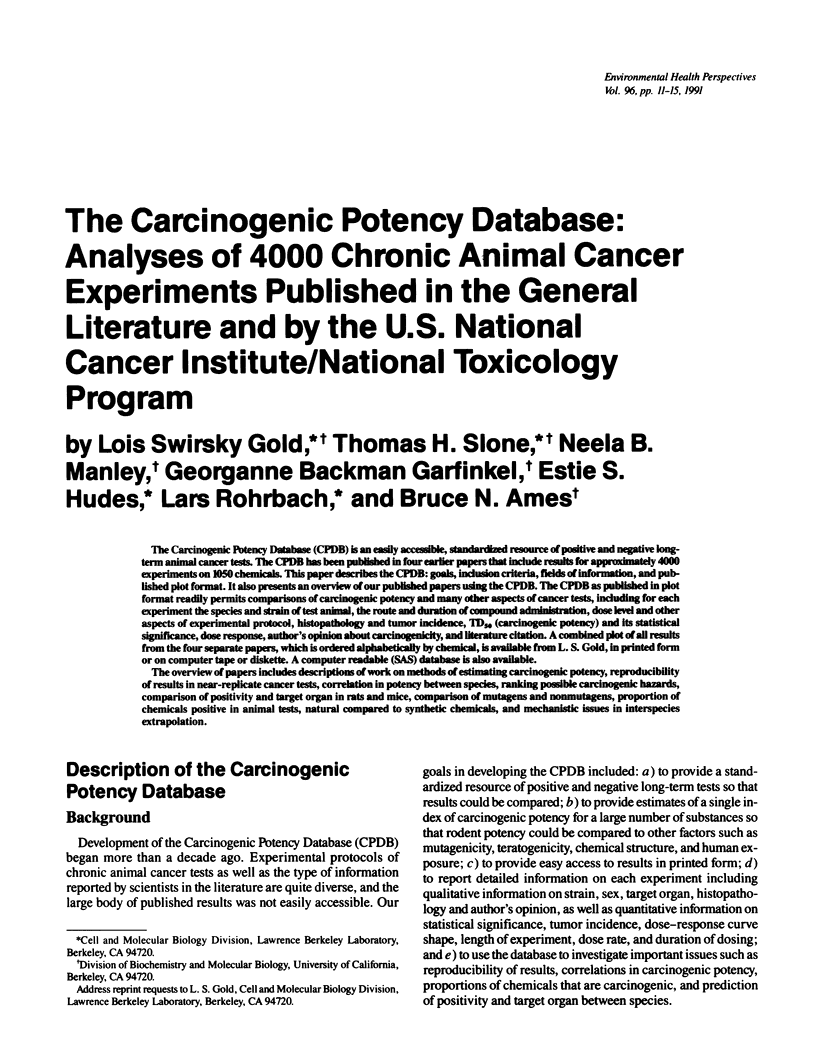
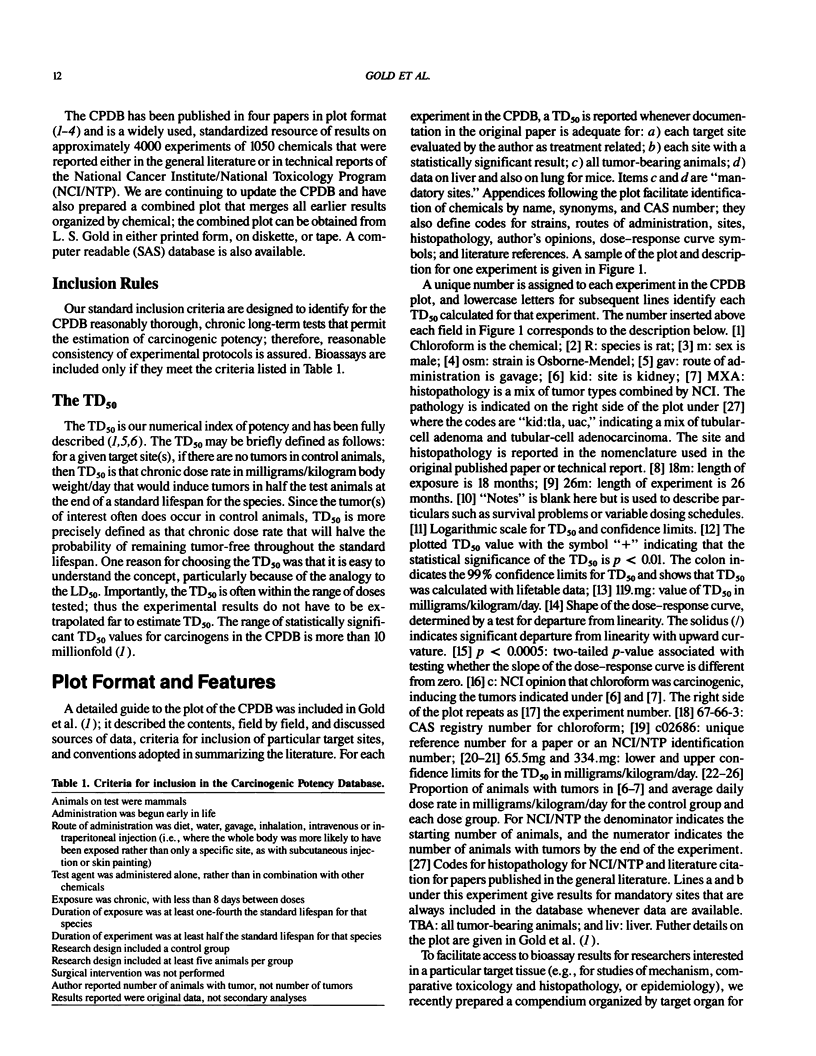
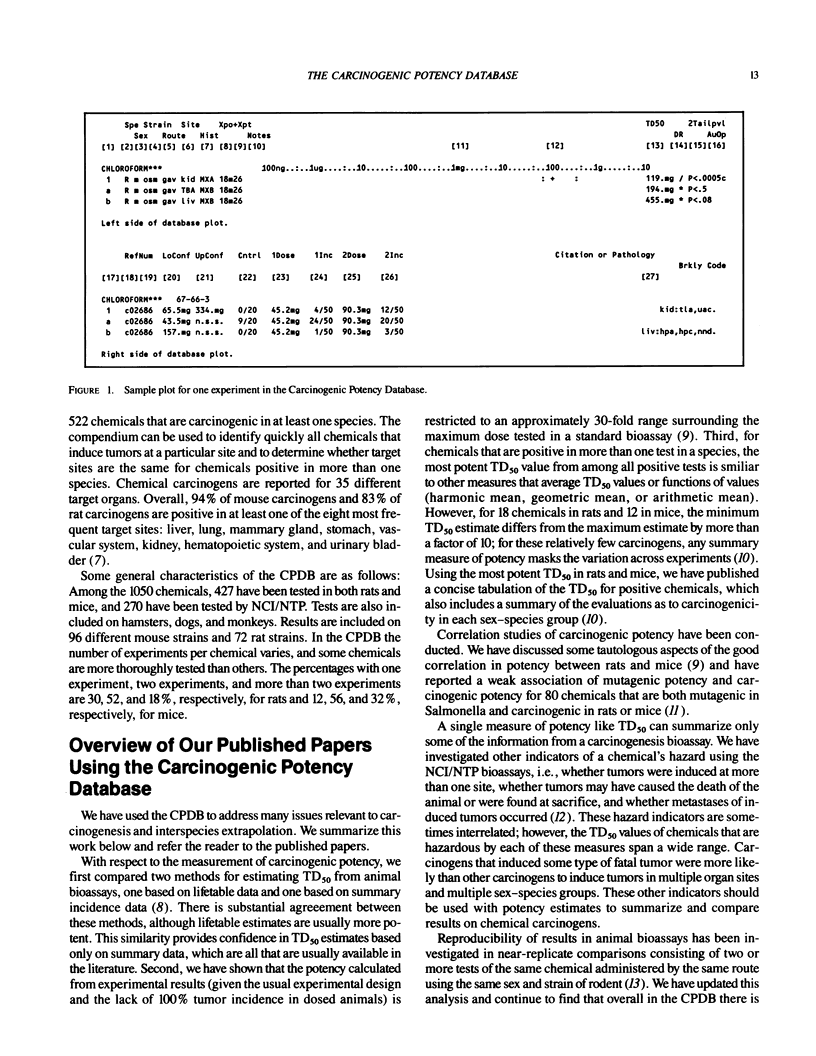
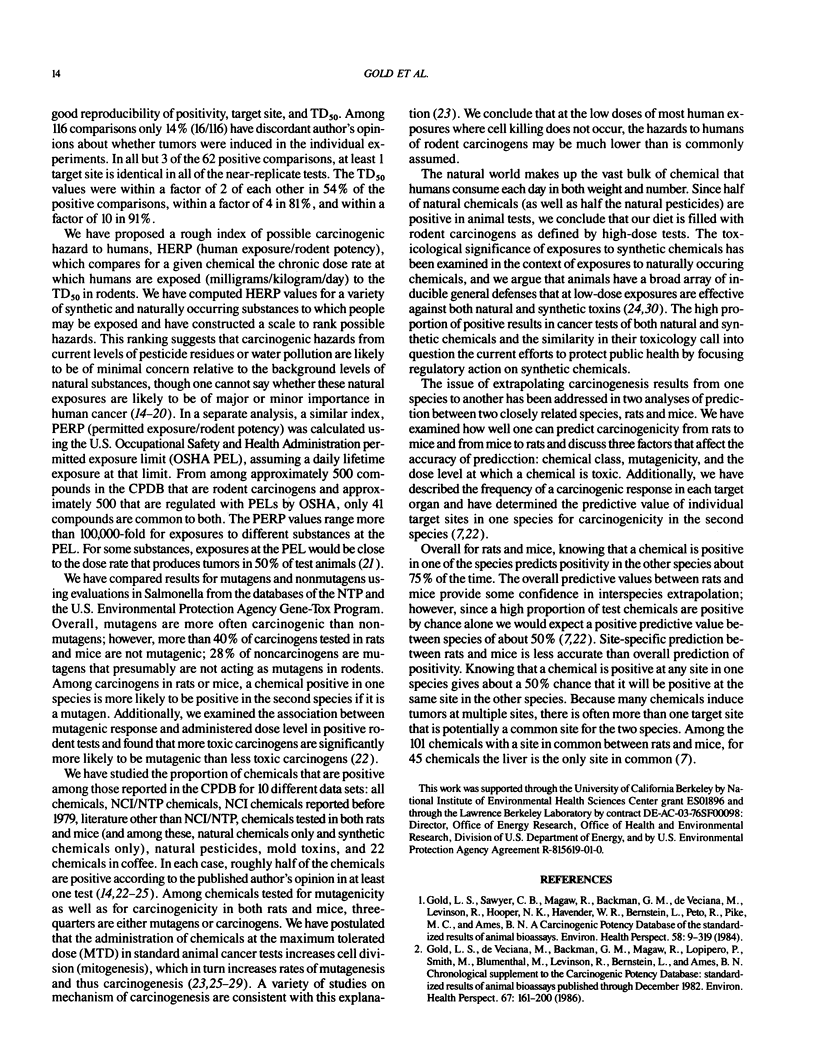
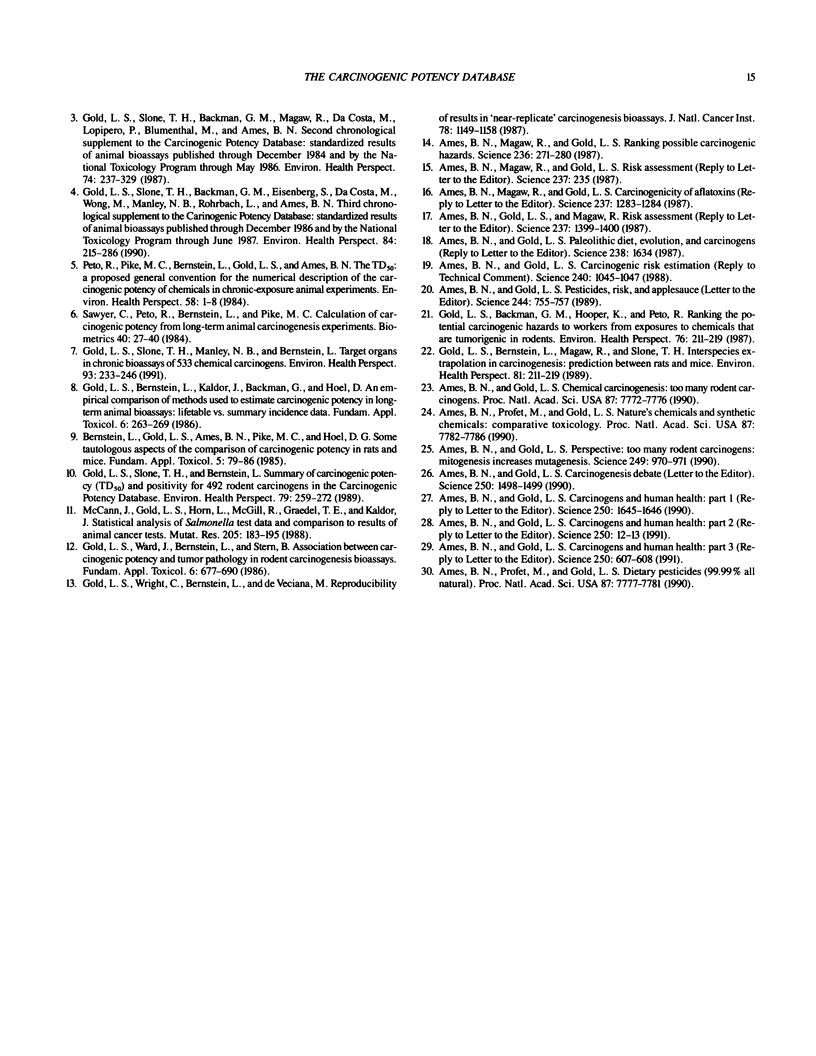
Selected References
These references are in PubMed. This may not be the complete list of references from this article.
- Ames B. N., Gold L. S. Carcinogenesis debate. Science. 1990 Dec 14;250(4987):1498–1499. [PubMed] [Google Scholar]
- Ames B. N., Gold L. S. Chemical carcinogenesis: too many rodent carcinogens. Proc Natl Acad Sci U S A. 1990 Oct;87(19):7772–7776. doi: 10.1073/pnas.87.19.7772. [DOI] [PMC free article] [PubMed] [Google Scholar]
- Ames B. N., Gold L. S. In reply: carcinogenic risk estimation. Science. 1988 May 20;240(4855):1045–1047. doi: 10.1126/science.240.4855.1045. [DOI] [PubMed] [Google Scholar]
- Ames B. N., Gold L. S. In reply: carcinogens and human health: part 1. Science. 1990 Dec 21;250(4988):1645–1646. doi: 10.1126/science.250.4988.1645. [DOI] [PubMed] [Google Scholar]
- Ames B. N., Gold L. S. Pesticides, risk, and applesauce. Science. 1989 May 19;244(4906):755–757. doi: 10.1126/science.2727679. [DOI] [PubMed] [Google Scholar]
- Ames B. N., Gold L. S. Response. Science. 1991 Jan 4;251(4989):12–13. doi: 10.1126/science.251.4989.12. [DOI] [PubMed] [Google Scholar]
- Ames B. N., Gold L. S. Response. Science. 1991 Feb 8;251(4994):607–608. doi: 10.1126/science.251.4994.607. [DOI] [PubMed] [Google Scholar]
- Ames B. N., Gold L. S. Response: paleolithic diet, evolution, and carcinogens. Science. 1987 Dec 18;238(4834):1634–1634. doi: 10.1126/science.238.4834.1634. [DOI] [PubMed] [Google Scholar]
- Ames B. N., Gold L. S. Too many rodent carcinogens: mitogenesis increases mutagenesis. Science. 1990 Aug 31;249(4972):970–971. doi: 10.1126/science.2136249. [DOI] [PubMed] [Google Scholar]
- Ames B. N., Magaw R., Gold L. S. Ranking possible carcinogenic hazards. Science. 1987 Apr 17;236(4799):271–280. doi: 10.1126/science.3563506. [DOI] [PubMed] [Google Scholar]
- Ames B. N., Profet M., Gold L. S. Dietary pesticides (99.99% all natural). Proc Natl Acad Sci U S A. 1990 Oct;87(19):7777–7781. doi: 10.1073/pnas.87.19.7777. [DOI] [PMC free article] [PubMed] [Google Scholar]
- Ames B. N., Profet M., Gold L. S. Nature's chemicals and synthetic chemicals: comparative toxicology. Proc Natl Acad Sci U S A. 1990 Oct;87(19):7782–7786. doi: 10.1073/pnas.87.19.7782. [DOI] [PMC free article] [PubMed] [Google Scholar]
- Bernstein L., Gold L. S., Ames B. N., Pike M. C., Hoel D. G. Some tautologous aspects of the comparison of carcinogenic potency in rats and mice. Fundam Appl Toxicol. 1985 Feb;5(1):79–86. doi: 10.1016/0272-0590(85)90051-x. [DOI] [PubMed] [Google Scholar]
- Gold L. S., Backman G. M., Hooper N. K., Peto R. Ranking the potential carcinogenic hazards to workers from exposures to chemicals that are tumorigenic in rodents. Environ Health Perspect. 1987 Dec;76:211–219. doi: 10.1289/ehp.8776211. [DOI] [PMC free article] [PubMed] [Google Scholar]
- Gold L. S., Bernstein L., Kaldor J., Backman G., Hoel D. An empirical comparison of methods used to estimate carcinogenic potency in long-term animal bioassays: lifetable vs summary incidence data. Fundam Appl Toxicol. 1986 Feb;6(2):263–269. doi: 10.1016/0272-0590(86)90239-3. [DOI] [PubMed] [Google Scholar]
- Gold L. S., Bernstein L., Magaw R., Slone T. H. Interspecies extrapolation in carcinogenesis: prediction between rats and mice. Environ Health Perspect. 1989 May;81:211–219. doi: 10.1289/ehp.8981211. [DOI] [PMC free article] [PubMed] [Google Scholar]
- Gold L. S., Sawyer C. B., Magaw R., Backman G. M., de Veciana M., Levinson R., Hooper N. K., Havender W. R., Bernstein L., Peto R. A carcinogenic potency database of the standardized results of animal bioassays. Environ Health Perspect. 1984 Dec;58:9–319. doi: 10.1289/ehp.84589. [DOI] [PMC free article] [PubMed] [Google Scholar]
- Gold L. S., Slone T. H., Backman G. M., Eisenberg S., Da Costa M., Wong M., Manley N. B., Rohrbach L., Ames B. N. Third chronological supplement to the carcinogenic potency database: standardized results of animal bioassays published through December 1986 and by the National Toxicology Program through June 1987. Environ Health Perspect. 1990 Mar;84:215–286. doi: 10.1289/ehp.9084215. [DOI] [PMC free article] [PubMed] [Google Scholar]
- Gold L. S., Slone T. H., Backman G. M., Magaw R., Da Costa M., Lopipero P., Blumenthal M., Ames B. N. Second chronological supplement to the Carcinogenic Potency Database: standardized results of animal bioassays published through December 1984 and by the National Toxicology Program through May 1986. Environ Health Perspect. 1987 Oct;74:237–329. doi: 10.1289/ehp.8774237. [DOI] [PMC free article] [PubMed] [Google Scholar]
- Gold L. S., Slone T. H., Bernstein L. Summary of carcinogenic potency and positivity for 492 rodent carcinogens in the carcinogenic potency database. Environ Health Perspect. 1989 Feb;79:259–272. doi: 10.1289/ehp.8979259. [DOI] [PMC free article] [PubMed] [Google Scholar]
- Gold L. S., Slone T. H., Manley N. B., Bernstein L. Target organs in chronic bioassays of 533 chemical carcinogens. Environ Health Perspect. 1991 Jun;93:233–246. doi: 10.1289/ehp.9193233. [DOI] [PMC free article] [PubMed] [Google Scholar]
- Gold L. S., Ward J. M., Bernstein L., Stern B. Association between carcinogenic potency and tumor pathology in rodent carcinogenesis bioassays. Fundam Appl Toxicol. 1986 May;6(4):677–690. doi: 10.1016/0272-0590(86)90181-8. [DOI] [PubMed] [Google Scholar]
- Gold L. S., Wright C., Bernstein L., deVeciana M. Reproducibility of results in "near-replicate" carcinogenesis bioassays. J Natl Cancer Inst. 1987 Jun;78(6):1149–1158. [PubMed] [Google Scholar]
- Gold L. S., de Veciana M., Backman G. M., Magaw R., Lopipero P., Smith M., Blumenthal M., Levinson R., Bernstein L., Ames B. N. Chronological supplement to the Carcinogenic Potency Database: standardized results of animal bioassays published through December 1982. Environ Health Perspect. 1986 Aug;67:161–200. doi: 10.1289/ehp.8667161. [DOI] [PMC free article] [PubMed] [Google Scholar]
- McCann J., Gold L. S., Horn L., McGill R., Graedel T. E., Kaldor J. Statistical analysis of Salmonella test data and comparison to results of animal cancer tests. Mutat Res. 1988 May-Aug;205(1-4):183–195. doi: 10.1016/0165-1218(88)90017-1. [DOI] [PubMed] [Google Scholar]
- Silbergeld E. K. Risk assessment. Science. 1987 Sep 18;237(4821):1399–1340. [PubMed] [Google Scholar]
- Stoloff L. Carcinogenicity of aflatoxins. Science. 1987 Sep 11;237(4820):1283–1284. doi: 10.1126/science.3629238. [DOI] [PubMed] [Google Scholar]


